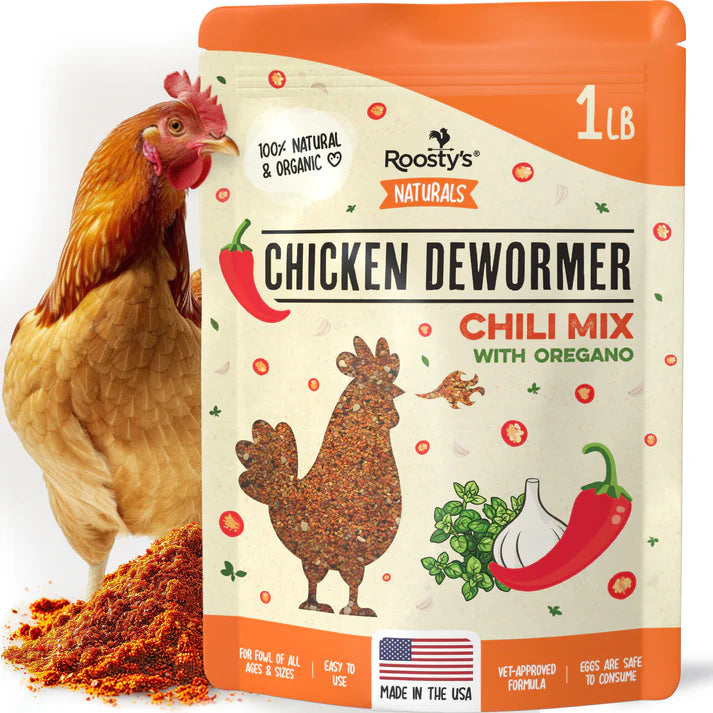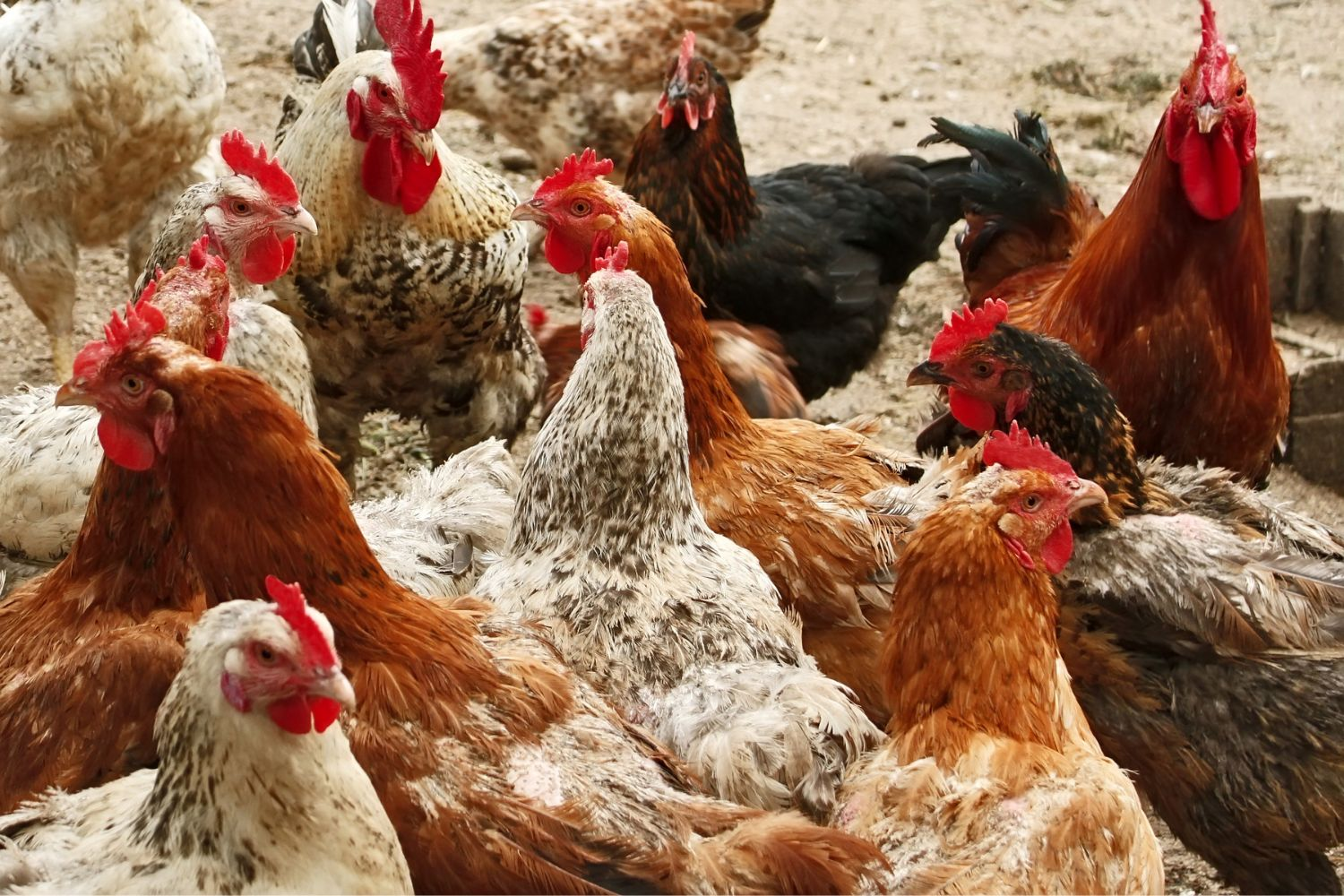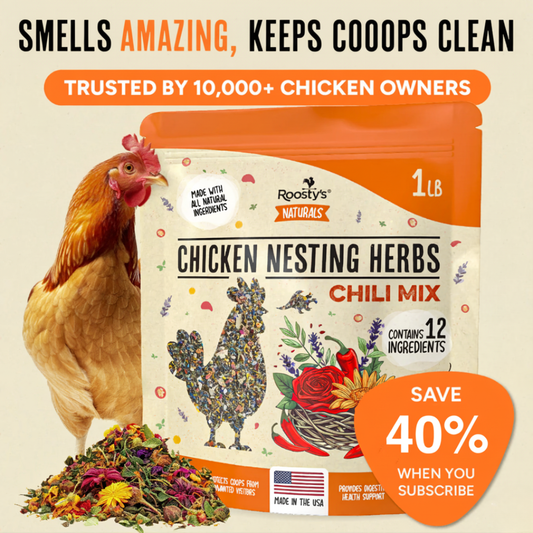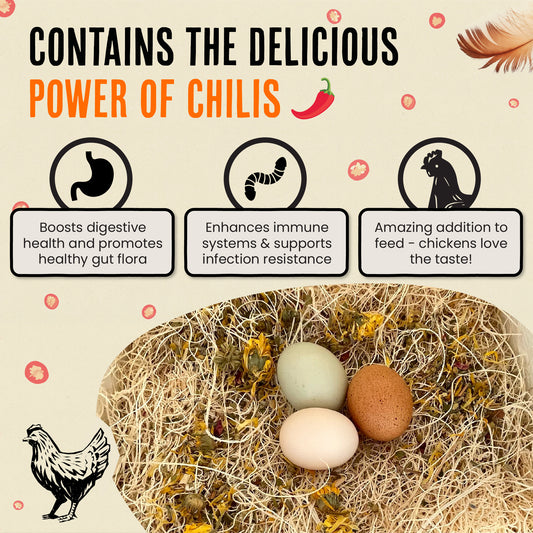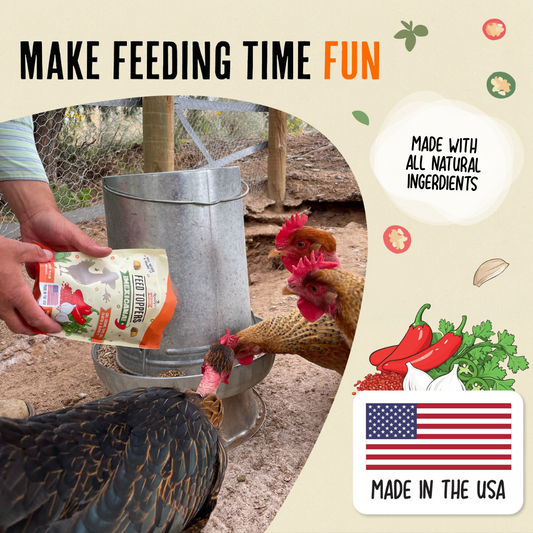
Chicken Coop Essentials: What's Inside for Happy Hens?

What do you need for a chicken coop to turn it into Cluckingham Palace? It turns out you need quite a bit! Chickens can sometimes be high-maintenance.
But not to worry, this blog has you covered. As experts in chicken coop accessories, we’ve compiled a list of everything you need to keep your birds safe, happy, and healthy.
This guide comes in two parts. The first section lists all the essential items you need in your chicken coop – the must-haves. The second half includes optional extras that you may want. As you go through the list below, you’ll discover new items you might not have thought of on your own.
So, without further ado, let’s look at the essential must-haves and other items for your chicken coop, and why you might need them.
Essential items and must-haves for a chicken coop

So, what should be inside a chicken coop? Here’s a list.
Food and Water
Food and water are the most essential additions to your chicken coop. Without them, your birds won’t last long!
Ideally, you want a bespoke feeder and drinker set specifically designed for chickens. These minimize mess and water spillage, helping to keep bedding fresh and deter pests.
Look for options with a broad base to prevent tipping. Also, check the documentation to ensure feeders are free from chemicals and plastics that might harm your birds, such as BPA.
You can use a regular bowl for food and water, but it is not advisable. Chickens will trample it, spilling the contents all over the ground or floor of the chicken coop.
Roosts or Roosting Bars
Roosts are another essential item for chicken coops. These perches let birds sleep slightly off the ground, where they feel most comfortable.
Chicken owners began including roosting bars in coops after noticing their birds wanted to be high up. Even though they can’t fly, chickens instinctively seek elevation to avoid predators and maintain their well-being.
But roosts are also essential for other reasons, such as keeping birds dry and away from lice, pests, and droppings.
Experts recommend a roosting area of approximately 2 inches by 8 inches for each chicken you own. Most pre-built coops come with roosting bars pre-installed, but adding them yourself is easy. Simple boards attached to your hen house’s interior should suffice.
Ensure you don’t place roosting bars so high that chickens can fly out of their enclosure. Double-check the flight height of your breed before installation.
Nesting Boxes
Nesting boxes are another chicken house essential. These enclosed spaces are small areas that encourage birds to lay eggs, mimicking natural hollows.
Failing to provide nesting boxes for hens can lead to problems. Birds may lay eggs in random places, making them difficult to find.
The debate over how many nesting boxes you should have per chicken continues to rage. Most experts suggest one per four or five hens, depending on your setup. However, you can include more if your breed lays prolifically.
Nesting boxes usually sit to the side of the main coop. Chickens can retire to them at night or in the early morning to lay before getting on with the rest of their day.
Bedding
Bedding is also one of the top must-haves for a chicken coop. Leaving birds on a bare wood or concrete floor can lead to unwanted health issues, some of which can be serious.
Various bedding types are available, including straw, hay, hemp, wood shavings, shredded paper, sand, and leaves. Each comes with pros and cons. For instance, straw is ideal for insulation, while sand is better for drainage.
Bedding can help keep chickens warm at night during the colder winter months. Laying down extra bedding prevents birds from suffering in northern climates.
You can also compost waste bedding into beautiful, dark, crumbly soil (except sand). Chicken manure decomposition takes approximately five to six weeks, while hay and straw may take a little longer.
Finally, bedding protects your birds’ feet against bumblefoot and keeps their feathers hygienic. Materials absorb moisture and help droppings dry out, reducing disease risks.
Bumblefoot is a condition you’ll want to avoid. If the infection goes on for long enough, it can be fatal. It can also make your birds’ lives miserable, preventing them from walking in extreme cases.
Ventilation
Another chicken coop must-have is ventilation. While you might think it would be a standard coop feature, not all have it. Many owners find themselves installing vents afterward when chickens get sick.
Ventilation is essential in chicken coops for several reasons. One of its main benefits is preventing moisture and condensation from building up inside. During cold months, the air temperature from multiple huddled hens can be significantly higher than wall or ceiling temperatures. Water droplets can form when this happens, increasing the risk of harmful mold and mildew.
Ventilation is also necessary for reducing the concentrations of harmful ammonia in chicken coops. Chicken manure produces vast quantities of the stuff, which needs to escape somehow. Without proper airflow, it can harm their lungs, causing breathing difficulties.
Finally, ventilation is necessary for reducing dust levels in your coop. Straw and wood shaving beddings can emit large volumes of microscopic particles into the air that damage chickens’ respiratory systems.
In general, always look for chicken coops with pre-installed ventilation. If you install it yourself, place it high up, just below the roofline.
Run
A run is also high on the list of essential requirements for a chicken coop. While it is not strictly a part of the hen house, chickens still need one to remain fit, healthy, and active.
But what is a run? Essentially, it’s a fenced area next to your chicken coop where birds can roam freely. Owners install them for two reasons:
- To keep birds in an enclosed area and stop them from wandering off
- To keep predators out
Chicken runs should provide approximately 10 square feet per chicken. Spreading them out helps to keep animals calm and avoids unsanitary conditions.
Room
Lastly, on our list of essentials, you’ll want to ensure your chickens have enough room inside the coop. Packing them too tightly can lead to pecking and fights.
Most coop manufacturers will tell you how many chickens their coops can accommodate. Depending on the breed, many will quote a range (e.g., 6 to 8 hens).
If you can afford it, choose larger accommodation. Chickens will get along with each other better and have enough space to feel calm.
What Else To Include In Your Chicken Coop?

The items discussed in the last section were the chicken coop essentials. However, there are many other items you can include to enhance egg production and your birds’ quality of life.
Dust Bath
For example, adding a dust bath can make your coop more hospitable. Chickens use these to remove parasites and spread oil over their feathers, keeping them in tip-top condition.
Creating a dust bath is pretty simple, even if you live in a wet climate. Simply cover a small patch of land in a way that prevents moisture from getting to it and allows it to desiccate.
If that’s not possible, you can use bagged ash or dusty sand and place it in a plastic tray.
Heat Source
You should also consider adding a heat source to your coop. Birds can get cold in the winter, especially when temperatures go below 35°F.
Choose a system based on flat-panel, radiative technology. It is cool to the touch even during operation and doesn’t contain any heating elements or open flames, reducing the risk of fire.
Also, avoid installing units that are too hot for your chickens. Aim to maintain your birds between 60°F and 75°F. Anything hotter than that can lead to heat exhaustion and death.
Many people used simple heat lamps in the past because they were cheap. However, they come with some considerable downsides, such as a higher risk of fire and the inability to control their heat output. Ideally, you want a system that works automatically or operates in a way that doesn’t harm your chickens, even if you leave it on all night.
Automatic Door
Another optional extra is an automatic door. These open and close by themselves, eliminating the need to go out to the coop every morning and evening.
Automatic doors are generally safe and easy to install. Chickens operate according to a daily rhythm, so locking them out accidentally is unlikely.
Nesting Box Access
You might also want your chicken coop to offer convenient nesting box access. Installing flaps (or buying a henhouse with them already built-in) reduces the effort of collecting eggs in the morning. It is also less distressing for your birds because you don’t need to go through the coop itself.
Enrichment
Another potential addition to your coop is enrichment features – objects and toys that help to keep your chickens’ minds active. Chickens need these to perform natural behaviors, reduce boredom, and improve cognition. Without them, fights can break out, and egg production can fall.
Chicken enrichment options include:
- A chicken swing that allows birds to rock gently back and forth
- A DIY snack or treat dispenser or treat piñata
- A dust bath
- Small, safe toys
- A peckable xylophone
- Wooden structures of different heights
- Food puzzles
The cool thing about chicken enrichments is that you can be creative. For some, it’s a craft hobby!
A Sign
You might also want to equip your coop with a sign to identify it, particularly if you keep many birds. Numbering coops can help when assigning chickens to hen houses or recording your inventory.
You can also use it to personalize your chicken coop. Adding a sign is a fun and creative way to make it your own.
Pest Control Systems
Most modern coops are made of thick, treated wood or toughened plastic and reinforced wire mesh to prevent rodents and other pests from causing harm. But sometimes, they can still get in. That’s why it’s essential to use rodent-proof containers and ensure your coop sits on solid ground.
If you have a serious rodent problem, place traps and deterrents around the coop in safe locations, away from your chickens. Don’t put them inside the hen house or run.
Grit
Grit, or small swallowable pebbles, is also something you could include. It helps chickens grind food in their gizzards, improving their digestion.
Don’t worry: it’s inexpensive. And, unlike food, it won’t spoil, create a mess, or attract pests.
Shade
Shade is another item to include in your chicken coop, especially if you live in a hot climate. Chickens can overheat in direct sun and experience exhaustion, but you can reduce the risk by adding shelter to an area of your run.
Roof Insulation
Roof insulation helps retain more heat in your coop during the winter and prevents the hot sun from warming the interior too much in the summer. Some manufacturers include it as part of bespoke coop builds, but you can use Styrofoam or another insulating material and add it yourself.
First Aid
You might also want to include a first aid kit in your coop purchase to deal with minor chicken-related injuries. Birds can hurt themselves in multiple ways, including cutting their feet.
Chicken first aid kits should contain:
- Disposable gloves
- Vitamins and electrolytes
- Vetrap
- Eye droppers
- Syringes
- Epsom soaking salt
- Gauze pads
- Tape
- Various care sprays
Heated Water
Finally, you might want to provide your chickens with a heated water supply. These systems prevent water from freezing in cold climates, ensuring your birds always have something to drink.
So, What Should You Include In Your Chicken Coop?
Now that you've read this, you know the answer to the question, "What do chicken coops need?"
Figuring out what to put in a chicken coop is easy once you understand your birds’ requirements. As discussed, essential items include:
- Food and water feeders
- Roosts
- Nesting boxes
- Bedding
- Ventilation
- A run
- Sufficient room
Other items you may need, depending on your circumstances, include:
- Dust bath
- Heat source
- Automatic door
- Nesting box access
- Enrichment
- Grit
- Shade
- Roof insulation
- Heated water
Ultimately, what to put in chicken coops is a matter of researching what your birds need and finding solutions. There are endless possibilities, so start exploring today!
